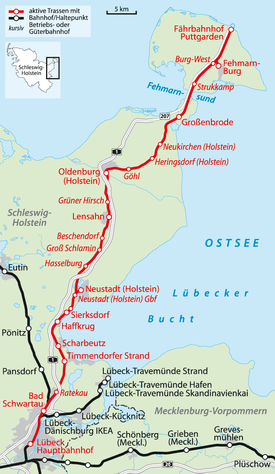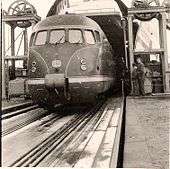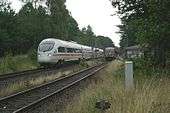Lübeck–Puttgarden railway
The Lübeck–Puttgarden railway is part of the international Vogelfluglinie (Bird Flight Line) between Germany and Denmark and connects Lübeck with Puttgarden on the Baltic Sea island of Fehmarn in the German state of Schleswig-Holstein.
| Lübeck–Puttgarden | |||||||||||||||||||||||||||||||||||||||||||||||||||||||||||||||||||||||||||||||||||||||||||||||||||||||||||||||||||||||||||||||||||||||||||||||||||||||||||||||||||||||||||||||||||||||||||||||||||||||||||||||||||||||||||||||||||||||||||||||||||||||||||||||||||||||||||||||||||||||||||||||||||||||||||||||||||||||||||||||||||||||||||||||||||||||||||||||||||||||||||||||||||||||||||||
|---|---|---|---|---|---|---|---|---|---|---|---|---|---|---|---|---|---|---|---|---|---|---|---|---|---|---|---|---|---|---|---|---|---|---|---|---|---|---|---|---|---|---|---|---|---|---|---|---|---|---|---|---|---|---|---|---|---|---|---|---|---|---|---|---|---|---|---|---|---|---|---|---|---|---|---|---|---|---|---|---|---|---|---|---|---|---|---|---|---|---|---|---|---|---|---|---|---|---|---|---|---|---|---|---|---|---|---|---|---|---|---|---|---|---|---|---|---|---|---|---|---|---|---|---|---|---|---|---|---|---|---|---|---|---|---|---|---|---|---|---|---|---|---|---|---|---|---|---|---|---|---|---|---|---|---|---|---|---|---|---|---|---|---|---|---|---|---|---|---|---|---|---|---|---|---|---|---|---|---|---|---|---|---|---|---|---|---|---|---|---|---|---|---|---|---|---|---|---|---|---|---|---|---|---|---|---|---|---|---|---|---|---|---|---|---|---|---|---|---|---|---|---|---|---|---|---|---|---|---|---|---|---|---|---|---|---|---|---|---|---|---|---|---|---|---|---|---|---|---|---|---|---|---|---|---|---|---|---|---|---|---|---|---|---|---|---|---|---|---|---|---|---|---|---|---|---|---|---|---|---|---|---|---|---|---|---|---|---|---|---|---|---|---|---|---|---|---|---|---|---|---|---|---|---|---|---|---|---|---|---|---|---|---|---|---|---|---|---|---|---|---|---|---|---|---|---|---|---|---|---|---|---|---|---|---|---|---|---|---|---|---|---|---|---|---|---|---|---|---|---|---|---|---|---|---|---|---|---|---|---|---|---|---|---|---|---|---|---|---|---|---|---|---|---|---|---|---|---|---|---|---|
 | |||||||||||||||||||||||||||||||||||||||||||||||||||||||||||||||||||||||||||||||||||||||||||||||||||||||||||||||||||||||||||||||||||||||||||||||||||||||||||||||||||||||||||||||||||||||||||||||||||||||||||||||||||||||||||||||||||||||||||||||||||||||||||||||||||||||||||||||||||||||||||||||||||||||||||||||||||||||||||||||||||||||||||||||||||||||||||||||||||||||||||||||||||||||||||||
| Overview | |||||||||||||||||||||||||||||||||||||||||||||||||||||||||||||||||||||||||||||||||||||||||||||||||||||||||||||||||||||||||||||||||||||||||||||||||||||||||||||||||||||||||||||||||||||||||||||||||||||||||||||||||||||||||||||||||||||||||||||||||||||||||||||||||||||||||||||||||||||||||||||||||||||||||||||||||||||||||||||||||||||||||||||||||||||||||||||||||||||||||||||||||||||||||||||
| Locale | Schleswig-Holstein | ||||||||||||||||||||||||||||||||||||||||||||||||||||||||||||||||||||||||||||||||||||||||||||||||||||||||||||||||||||||||||||||||||||||||||||||||||||||||||||||||||||||||||||||||||||||||||||||||||||||||||||||||||||||||||||||||||||||||||||||||||||||||||||||||||||||||||||||||||||||||||||||||||||||||||||||||||||||||||||||||||||||||||||||||||||||||||||||||||||||||||||||||||||||||||||
| Line number | 1100 | ||||||||||||||||||||||||||||||||||||||||||||||||||||||||||||||||||||||||||||||||||||||||||||||||||||||||||||||||||||||||||||||||||||||||||||||||||||||||||||||||||||||||||||||||||||||||||||||||||||||||||||||||||||||||||||||||||||||||||||||||||||||||||||||||||||||||||||||||||||||||||||||||||||||||||||||||||||||||||||||||||||||||||||||||||||||||||||||||||||||||||||||||||||||||||||
| Technical | |||||||||||||||||||||||||||||||||||||||||||||||||||||||||||||||||||||||||||||||||||||||||||||||||||||||||||||||||||||||||||||||||||||||||||||||||||||||||||||||||||||||||||||||||||||||||||||||||||||||||||||||||||||||||||||||||||||||||||||||||||||||||||||||||||||||||||||||||||||||||||||||||||||||||||||||||||||||||||||||||||||||||||||||||||||||||||||||||||||||||||||||||||||||||||||
| Line length | 88.6 km (55.1 mi) | ||||||||||||||||||||||||||||||||||||||||||||||||||||||||||||||||||||||||||||||||||||||||||||||||||||||||||||||||||||||||||||||||||||||||||||||||||||||||||||||||||||||||||||||||||||||||||||||||||||||||||||||||||||||||||||||||||||||||||||||||||||||||||||||||||||||||||||||||||||||||||||||||||||||||||||||||||||||||||||||||||||||||||||||||||||||||||||||||||||||||||||||||||||||||||||
| Track gauge | 1,435 mm (4 ft 8 1⁄2 in) standard gauge | ||||||||||||||||||||||||||||||||||||||||||||||||||||||||||||||||||||||||||||||||||||||||||||||||||||||||||||||||||||||||||||||||||||||||||||||||||||||||||||||||||||||||||||||||||||||||||||||||||||||||||||||||||||||||||||||||||||||||||||||||||||||||||||||||||||||||||||||||||||||||||||||||||||||||||||||||||||||||||||||||||||||||||||||||||||||||||||||||||||||||||||||||||||||||||||
| Operating speed | 140 km/h (87.0 mph) (maximum) | ||||||||||||||||||||||||||||||||||||||||||||||||||||||||||||||||||||||||||||||||||||||||||||||||||||||||||||||||||||||||||||||||||||||||||||||||||||||||||||||||||||||||||||||||||||||||||||||||||||||||||||||||||||||||||||||||||||||||||||||||||||||||||||||||||||||||||||||||||||||||||||||||||||||||||||||||||||||||||||||||||||||||||||||||||||||||||||||||||||||||||||||||||||||||||||
| Route number | 141 | ||||||||||||||||||||||||||||||||||||||||||||||||||||||||||||||||||||||||||||||||||||||||||||||||||||||||||||||||||||||||||||||||||||||||||||||||||||||||||||||||||||||||||||||||||||||||||||||||||||||||||||||||||||||||||||||||||||||||||||||||||||||||||||||||||||||||||||||||||||||||||||||||||||||||||||||||||||||||||||||||||||||||||||||||||||||||||||||||||||||||||||||||||||||||||||
| |||||||||||||||||||||||||||||||||||||||||||||||||||||||||||||||||||||||||||||||||||||||||||||||||||||||||||||||||||||||||||||||||||||||||||||||||||||||||||||||||||||||||||||||||||||||||||||||||||||||||||||||||||||||||||||||||||||||||||||||||||||||||||||||||||||||||||||||||||||||||||||||||||||||||||||||||||||||||||||||||||||||||||||||||||||||||||||||||||||||||||||||||||||||||||||
Route
The tracks of the Kiel–Lübeck railway are used from Lübeck to Bad Schwartau. The line then runs along the Baltic coast through Timmendorfer Strand, Scharbeutz, Haffkrug and Sierksdorf. In the Neustadt in Holstein freight yard a branch line separates and runs to Neustadt station. The main line continues through eastern Holstein and runs via Lensahn, Oldenburg in Holstein, Großenbrode and after crossing the Fehmarn Sound on the Fehmarn Sound Bridge it ends at Puttgarden station on Fehmarn.
History
The first section of the Lübeck–Puttgarden line to be built was the 23 kilometre section from Neustadt to Oldenburg. This was built by the Oldenburg District Railway (Kreis Oldenburger Eisenbahn, KOE) and opened on 30 September 1881. On 17 January 1898, the line was extended towards Lütjenbrode and Heiligenhafen (20 km).
A direct connection from Lübeck to Neustadt was missing for decades, as Neustadt was only connected with Lübeck via the Eutin–Neustadt line, requiring a change in Eutin. The direct connection opened between Lübeck and Neustadt by Deutsche Reichsbahn was not opened until 1 June 1928.
Idea of a "bird flight line"
Already in the 1920s, Deutsche Reichsbahn (DRG) and the Danish State Railways (DSB) had adopted the idea of the engineer Gustav Kröhnke (1826–1904) to establish a rail ferry link across the Fehmarn Belt between Puttgarden and Rødby. Also a bridge across the Fehmarn was planned for the first time in 1921. On the German side there were by this time the line from Lübeck to Hamburg of the Lübeck-Büchen Railway Company (German: Lübeck-Büchener Eisenbahn, LBE) and the KOE from Neustadt in Holstein to Heiligenhafen. The KOE also owned the Fehmarn Island Railway (Inselbahn Fehmarn), which operated a train ferry to Fehmarn.
The first construction plans for the bird's flight line were drawn up in 1940 by Heinrich Bartmann. A formal intergovernmental agreement was signed between Deutsche Reichsbahn and the occupied Kingdom of Denmark on 8 April 1941. The LBE was acquired by the DRG on 1 January 1938. It took over the Eutin-Lübeck Railway Company (Eutin-Lübecker Eisenbahn, ELE), which owned part of the Kiel–Lübeck railway, in January 1941 and the KOE on 1 August. In September of that year construction work began, both in Germany and in Denmark. Second World War priorities brought work to a halt in 1943.
To 1951: Großenbrode Quay

Construction recommenced in 1949. The line the former KOE was modernised, a bypass curve was built around Lütjenbrode and the connecting line to bypass Neustadt was finished. A ferry terminal, Großenbrode Quay (Großenbrode Kai) was created on the grounds of the former Großenbrode airbase, which was connected by an existing siding to Grossenbrode station.
On 15 July 1951, Deutsche Bundesbahn and the DSB opened with a train ferry service between the Großenbrode Quay and Gedser on the Danish island of Falster.
From 1963: Fehmarn Sound Bridge
The construction of the connection from Großenbrode to Puttgarden on the north coast of Fehmarn began in 1958. On 14 May 1963, the Fehmarn Sound Bridge was opened in the presence of German President Heinrich Lübke and the Danish King Frederik IX. The ferry link across the Fehmarn Belt was opened along with Fehmarn Sound Bridge, creating the Bird Flight Line in its present form. The nearby train ferry across the Fehmarn Belt from Grossenbrode was closed at the same time.
The Bird Flight Line was subsequently used by many important long distance trains such as the Nord Express and the Italia Express (Rome–Copenhagen). Added to this was busy freight traffic. Thus, for example, according to Deutsche Bahn 190,757 freight wagons used the train ferry in 1994. "D-trains" (D-Züge: long-distance expresses), the Trans Europ Express Merkur and Trans-Europ-Express-Marchandises (TEEM) international freight trains ran to Puttgarden, hauled by diesel locomotives of class 221 and later of class 218 in double traction and the large Soviet diesel locomotives of class 232.
In regional and local transport, Deutsche Bundesbahn continued to operate between Lübeck and Puttgarden with Silberling carriages hauled by class 212 locomotives, some of which ran on the branch line to Heiligenhafen and continued on to Fehmarn.
Also from 1963 to 1983 during the summer months, when the Baltic Sea was mainly used by tourists, the Fehmarn-Express ran from Cologne via the Ruhr, Westphalia, Hanover, Lauenburg and some of the resorts on the Bay of Lübeck to Puttgarden or Burg on Fehmarn. Not many seaside resorts were located on the route, so there were bus connections to, for example, Dahme and Grömitz.
Because of the heavy traffic on the single track line, it was equipped in 1971 with train radio, initially for experimental purposes. Already in the 1970s most stops between Neustadt and Puttgarden had been abandoned and were served by buses.[2] Passenger services on the branch line from the rail triangle east of Lütjenbrode to Heiligenhafen were closed on 30 May 1976 and freight traffic on the branch was abandoned on 31 October 1984. The line is now closed.
After the commissioning of Great Belt Fixed Link between the Danish islands of Funen and Zealand in 1997, the train ferry was closed thus ending freight train traffic on the Bird Flight Line across the Fehmarn Belt. International freight traffic between the metropolitan areas of Hamburg and Copenhagen now runs via Flensburg and Fredericia. This means a detour of 160 km. Because of the reduced number of trains, the passing loops at Sierksdorf, Hasselburg and Beschendorf were closed.
It was decided to reopen a section of the Fehmarn Island Railway, to Burg, the largest town on Fehmarn. Construction was completed by the Easter of 2010 and the new station was finally opened at the timetable change in late July 2010. The Regional-Express trains from Lübeck have since branched off the main line at Burg-West and run to the new Fehmarn-Burg station. Some trains reverse immediately and continue on their journey to Puttgarden station; other trains return directly from Fehmarn-Burg station to Lübeck.
Current situation

The extensive freight sidings in Puttgarden are abandoned.
Rail traffic between Hamburg and Copenhagen is now greatly reduced compared to some years ago with a DB Intercity-Express service as well as a EuroCity service operated by DSB with IC3 trains. Neustadt station is a terminus on a short branch line, branching off to the east from the line from Lübeck. Therefore, long-distance trains from Hamburg/Lübeck to Puttgarden/Copenhagen bypass Neustadt. Regionalbahn trains run between Lübeck and Neustadt every hour. Regionalbahn services run between Lübeck and Puttgarden or Burg on Fehmarn every two hours. These trains run coupled between Lübeck and Sierksdorf and are coupled in Neustadt freight yard (southbound) or uncoupled there (northbound).
As the successor to the Fehmarn-Express—which ran from Hamburg via Büchen and Lüneburg—Intercity trains operate during the warmer six months daily (during the holidays twice daily) between Frankfurt, Cologne, the Ruhr, Hamburg and Fehmarn-Burg.
The Intercity stops are:
|
ICE and EC trains stop in the following stations:
|
Prospects
It is also planned to open the Fehmarn Belt Fixed Link in 2020 as a tunnel. A treaty in relation to the project was signed by the transport ministers of Germany and Denmark on 3 September 2008.[3] The section from Puttgarden to Lübeck has to be electrified by the time of the completion of the new link, but the duplication of the lines is not required until seven years after the completion of the fixed link. The Fehmarn Sound Bridge may remain single track. A review of the project was published on 11 November 2010, which found that it would have a benefit-cost ratio of 6.7.
In the Federal Transport Infrastructure Plan (Bundesverkehrswegeplan) 2030, Germany ear-marked 1.518 billion Euros for the electrification of the Lübeck–Puttgarden railway.[4] The plans are now to stop all traffic Neustadt – Puttgarden 2022–2026 for rebuilding the route.[5] Buses will have to be used instead of the trains on this section. The travel time Lübeck – Burg will be 49 minutes after reopening, 40 minutes faster than before. Deutsche Bahn has set up a website for the project: https://www.anbindung-fbq.de
Notes
- Eisenbahnatlas Deutschland (German railway atlas). Schweers + Wall. 2009. p. 4, 13, 118. ISBN 978-3-89494-139-0.
- DB-summer timetable of 1975
- "Immersed tunnel is the preferred solution". The Fehmarnbelt Fixed Link. Retrieved 13 December 2011.
- Search for "Puttgarden" in "Archived copy" (PDF). Archived from the original (PDF) on 2016-08-03. Retrieved 2016-08-12.CS1 maint: archived copy as title (link)
- Bahnstrecke nach Fehmarn ab 2022 fünf Jahre lang gesperrt
External links
- Schienenanbindung der Festen Fehmarnbeltquerung (Official site for the Fehmarn belt connection) (German)
References
- Friedhelm Ernst (ed.). "Die Vogelfluglinie". Eisenbahn-Kurier (in German). Freiburg (Breisgau): EK Verlag. 53 (Special).
- Olaf Hamelau, ed. (2010). Die Eisenbahn in Ostholstein (in German). Erfurt: Sutton-Verlag. ISBN 978-3-86680-589-7.